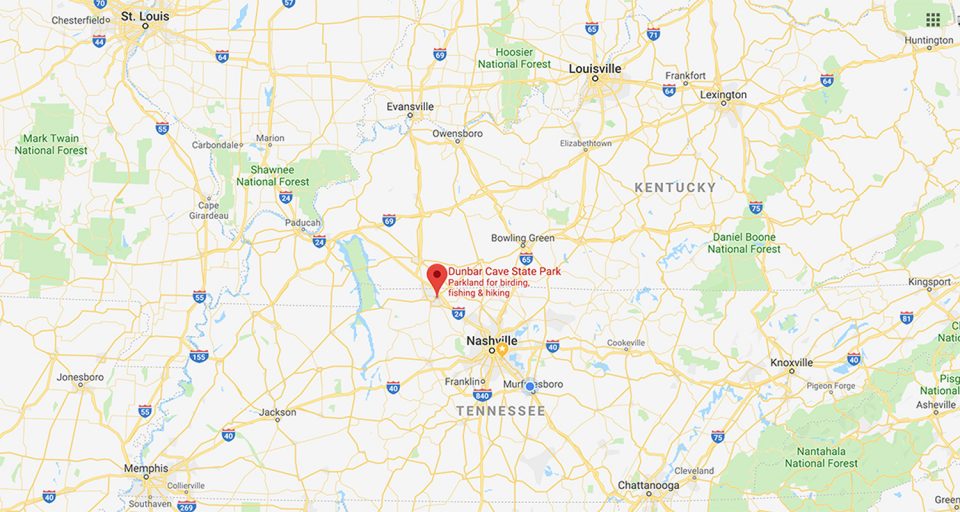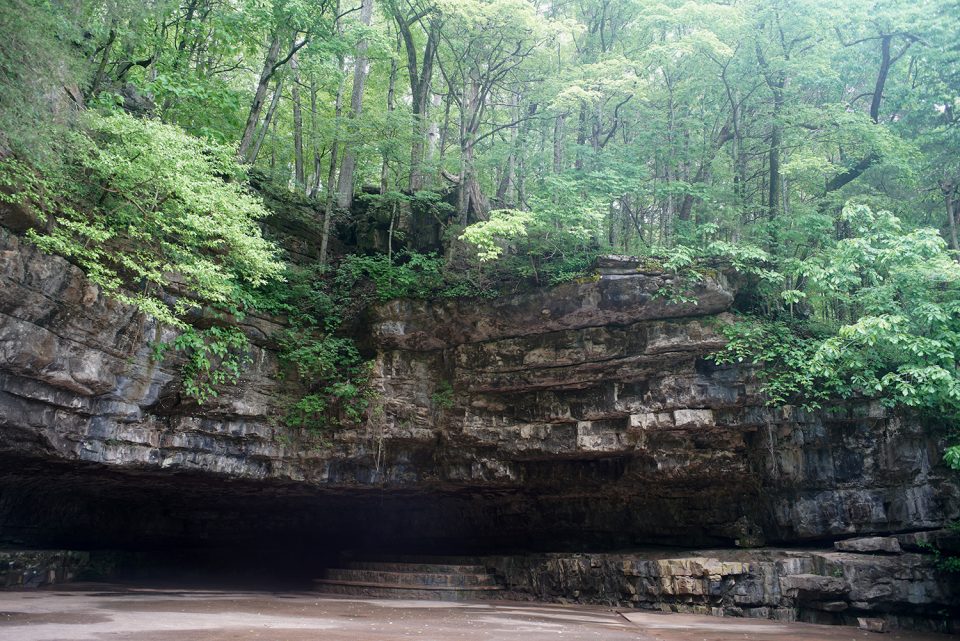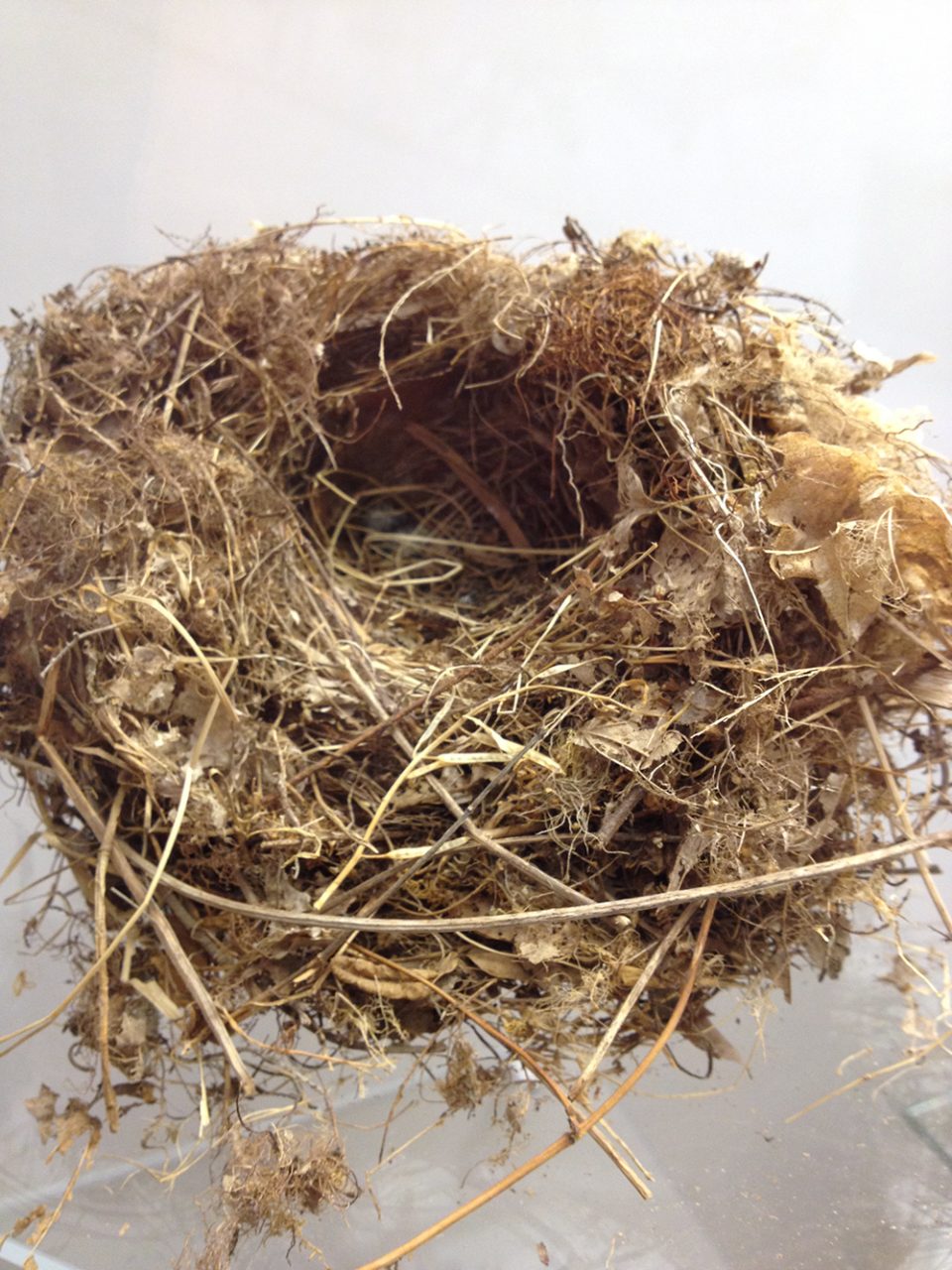Dunbar Cave State Park: Walk through a sacred cave with ancient Native American petroglyphs
Scroll to bottom to read my experience on the cave tour
Tennessee is blessed with some of the most spectacular state parks in the Eastern US, with more than 80 waterfalls and 1,100 miles of hiking trails. Many of the parks have Native American significance, including Dunbar Cave State Park. This is a cave tour with a special treat — ancient Native American sacred petroglyphs.
The park holds historical, natural, archaeological, and geological features, and hosts community events in the large entrance to Dunbar Cave.

Location of Dunbar Cave State Park
Address: 401 Old Dunbar Cave Rd, Clarksville, TN 37043
Website: tnstateparks.com
Phone: (931) 648-5526
Google map: Go to the Google Map
Located near Clarksville in Northwest Tennessee less than an hour from Nashville, this park is close to the Kentucky state line and is easily accessible to residents of Illinois, Missouri, Arkansas, Indiana, and Alabama. Tennessee State Parks are free for state residents and out-of-state visitors alike. However, the cave tours do have an entry fee (see details below).

History of Dunbar Cave
The Dunbar Cave site has a long history of Native American activity, stretching way back to the Paleo era (10000–8000 B.C.). It was occupied for thousands of years, with most of the artifacts found by archaeologists dating to the Archaic era (from 8000–1000 B.C.).
During the Mississippian era (800–1550 A.D.), the cave was a sacred ceremonial site, and this is the period the petroglyphic cave art was created.
The cave property was claimed by the Dunbar family in the 1700s, but never deeded, and was subsequently also claimed by Robert Nelson who received the deed and won a legal fight over the property. Even though the Dunbar family was removed from the property, the cave retained their name.
The cave was a source of saltpeter during the Mexican-American War, and after the Civil War, a hotel was built nearby. The region became a tourist destination, and singer Roy Acuff bought the cave in 1948, using it as a music venue and adding a golf course to the property. After a few years, the hotel burned and popularity declined.
The State of Tennessee purchased the cave property in the 1970s.
Dunbar Cave Tour Prices
Ages 13+ = $15.00
Under age 13 = $9.00
Age 5 and under not permitted

Register for Dunbar Cave Tours
Tours are seasonal and begin in May. You can pick a tour date and register / pay in advance on the Tennessee State Parks Dunbar Cave Tour website. Start here:
Dunbar Cave Tours Registration
Dunbar Cave Policies
There are a lot of rules related to this tour. This information was pasted directly from the official Dunbar Cave registration page:
You must bring a HANDHELD flashlight. If you do not, flashlights are available for purchase in gift shop. No lanterns, cellphones, or headlamps. The following items are not allowed on tours: backpacks, large bags, strollers, child carriers, tripods or similar items. Photography is not allowed inside the cave due to presence Native American religious symbols. The temperature inside the cave is 58ºF. You may wish to bring a light jacket during your tour.
Cave walkways are relatively flat but muddy and/or slippery in places. Some stooping and climbing of steps is necessary. Because of the conditions of the cave, it is not handicap accessible and not recommended for people with mobility issues. Children under the age of 5 are not permitted in the cave.
Please note the following: Arrive in plenty of time to park and check in. There is limited parking and tours begin promptly. All cave tour participants must sign a liability waiver at front desk prior to entering the cave.
As a photographer, it’s a bit of a bummer that photography isn’t allowed, but I understand and appreciate the reasoning.
My experience on the Dunbar Cave Tour
I registered for the 9am tour on the first Saturday of the season (season opens in May). While tours accept up to 20 people, my tour consisted of myself, a family of three, the tour guide, a park ranger, and a second tour guide walking along.
Bring a very bright flashlight — As the rules state, you must bring or purchase a flashlight because there is no electricity inside the cave. Bring the brightest flashlight you can find. My flashlight is one of those mini Maglite-style LED lights, and while it seems very bright, it was small and dim inside the darkness of the cave. The tour guides had very bright lights. After the tour I ordered this one from Amazon and it’s much brighter than my old one.
Tour lasted 1 hour — Our tour lasted about an hour, but a group with more people would probably last longer. Our guide was new, and he walked us through pretty quickly.
Slippery when wet — The cave is wet inside, with numerous shallow puddles, muddy spots, and slippery wooden planks and rocks. I wore my Oboz hiking shoes with trail gripping soles, and I felt no slippage on the walk.
The tour is not accessible for anyone in a wheelchair or with mobility problems. In a couple of areas, you must bend pretty low to walk through, and the metal gate at the entrance has a knee-high barricade that you must step over to enter the cave mouth.
Rock formations and graffiti — Inside the cave, you’ll see interesting natural things like silver cave moss, and of course, a few beautiful examples of rock formations. However, this is not the cave to visit if you want epic cave formations.
Since the cave was formerly privately-owned and left open to party-people from the entertainment venue just outside the cave’s mouth, it suffered a lot of vandalism. Actually, some of the vandalism predates the Civil War. Names and dates are scratched, etched, and smoked onto many of the caves walls, rock formations, ceilings.
There are several examples of stalagmites that have been broken off, leaving only fractured nubs. In one of the rooms, labelled on the cave wall as Herculaneum (after the ancient Roman neighbor to Pompeii), thousands of names have been left behind. It’s so prevalent, graffiti almost seems to have been encouraged. Luckily, the age of it makes it an interesting and somewhat unique aspect of the cave tour.
Cold war rations — In one of the smaller rooms of the cave, there’s a blackened room with a pile of concrete rubble and old canisters leftover from the era when the cave was equipped as a cold war air raid shelter. Here you can see a blackened old piece of rations, which survived a fire set by vandals that scorched the room and caused the collapse of the concrete wall inside the shelter.
Ancient Native American cave art — For me, the real reason to visit Dunbar Cave is the 800-year-old Mississippian culture wall art. When you arrive at the location of the art, which is on the cave wall only a few feet from floor level, the tour guide switches to a red-filtered flashlight to point out the black markings, which are actually pretty hard to distinguish.
Installed signage illustrates more clearly the art you’re seeing before you. There are two symbols, which are thought to represent the middle world (Earth) and the lower world (the underworld or the land of the dead).
A third drawing nearby shows a reclining humanoid figure, possibly a supernatural warrior or a great chief. This figure could potentially represent the location of a burial, although the guide said there’s no evidence of a grave.
Much respect to the ancient artists, who would have had to enter the so-called “dark zone” of the cave with handheld torches made of bundled cane stems. They would have had to belly-crawl part of the way (although that’s not necessary now thanks to the labors of prisoners who dug out a foot path). This would have been a powerful act of faith for them.
Thanks for reading!
Be sure to visit me on Facebook, Google+ or Pinterest, or on my website at keithdotson.com.
~ Keith
Become a Patron!Note: This article contains Amazon links. I may earn a small commission on qualifying purchases.
